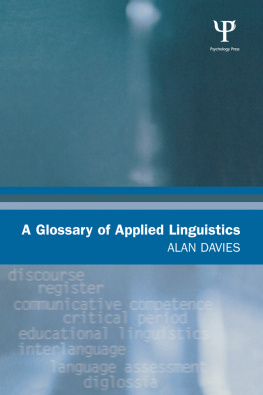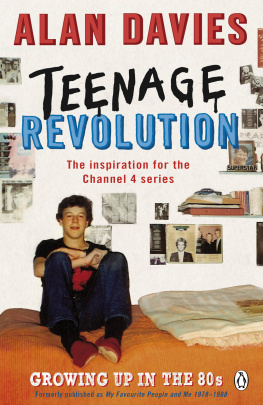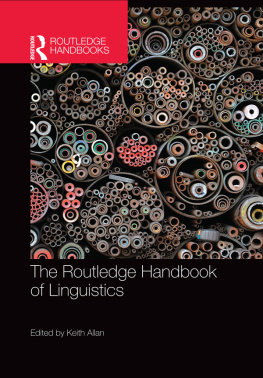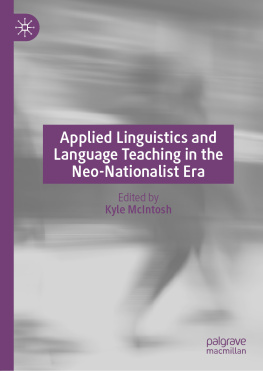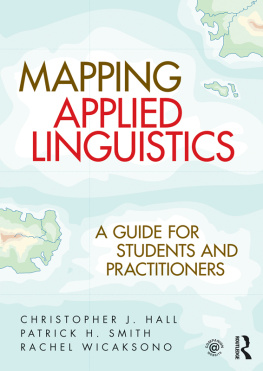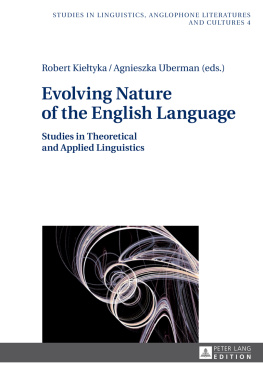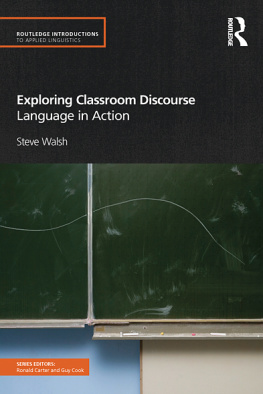A GLOSSARY OF APPLIED LINGUISTICS
A Glossary of Applied Linguistics
Alan Davies
First published 2005 by
Lawrence Erlbaum Associates, Inc.
Published 2016 by Psychology Press
27 Church Road, Hove, East Sussex, BN3 2FA
and by Psychology Press
711 Third Avenue, New York, NY 10017
Psychology Press is an imprint of the Taylor & Francis Group, an informa business
Copyright Alan Davies.
All rights reserved. No part of this book may be reprinted or reproduced or utilised in any form or by any electronic, mechanical, or other means, now known or hereafter invented, including photocopying and recording, or in any information storage or retrieval system, without permission in writing from the publishers.
Trademark notice: Product or corporate names may be trademarks or registered trademarks, and are used only for identification and explanation without intent to infringe.
Library of Congress Cataloging-in-Publication data
Davies, Alan, Ph. D.
A glossary of applied linguistics / Alan Davies.
p. cm.
Includes bibliographical references and index.
ISBN 0-8058-5728-1 (alk. paper) ISBN 978-0-8058-5729-0 (pbk. : alk. paper)
1. Applied linguisticsTerminology. I Title.
P129.D368 2005
418'.001'4dc22
ISBN-13: 978-1-315-04559-7 (eISBN)
Contents
Writing a single authored glossary of applied linguistics has advantages and disadvantages. The advantages are, it is to be hoped, coherence and a unified perspective. The disadvantages are the lack of expertise across so wide-ranging a field and the inevitable solitariness of the task. But, as Dr Johnston's old friend, Mr Edwards, remarked: 'cheerfulness was always breaking in', encouraged as I have been by Catherine Elder and by Sarah Edwards of EUP, and delighted as I have also been by my grandchildren, George, Alice and Hannah.
Acronyms in the glossary are normally explained. Some that are not and are made use of several times are:
- Lx Source language
- Ly Target language
- L1 First language
- L2 Second language - any second language since for an individual it may be the second, third or fourth
Terms highlighted within entries will be found as headwords elsewhere in the Glossary,
The text refers to a number of scholars. These include:
- Anderson, Benedict
- Bakhtin, Mikhail
- Barth, Frederik
- Bernstein, Basil
- Bormuth, John R.
- Brass, Paul
- Brumfit, Christopher
- Carroll, John B.
- Chomsky, Noam
- Corder, S. Pit
- Cummins, Jim
- Fairclough, Norman
- Ferguson, Charles
- Firth, John R.
- Foucault, Michel
- Francis, Nelson
- Garfinkel, Harold
- Guttman, Louis
- Halliday, Michael A. K.
- Hymes, Dell
- Johnson, Samuel
- Jones, Daniel
- Kachru, Braj
- Labov, William
- Lakoff, George
- Lambert, Wallace E.
- Lantolf, James
- Le Page, Robert
- Likert, Renis
- Malinowski, Bronislaw
- Marx, Karl
- Osgood, Charles E,
- Perren, George E.
- Phillipson, Robert
- Piaget, Jean
- Sapir, Edward
- Sapon, Stanley M.
- Saussure, Ferdinand de
- Selinker, Larry
- Spolsky, Bernard
- Thurstone, Louis Leon
- Voloshinov, Valentin
- Vygotsky, Lev
- Weir, Cyril
- Whorf, Benjamin Lee
- Widdowson, Henry G.
The urgent question mark against applied linguistics is just what is its source, what exactly is being applied. If the interpretation of applied linguistics is very narrow so that what is being applied is only linguistics, then because linguistics, like other theoretical disciplines, deals with idealisations, it appears to have very little to say about the language-related problems in what we call the real world. If applied linguistics is interpreted very broadly, then it must concern itself with everything to do with language. Neither position is tenable. Linguistics, it seems, must play an important role in applied linguistics but by no means the only role. Applied linguistics must also draw on psychology, sociology, education, measurement theory and so on.
It may be that we shall gain a clearer picture of the nature of applied linguistics if we turn our attention away from the source (what applied linguistics draws on) to its target (what applied linguistics equips you to do). The target clearly cannot be anything and everything to do with language. Corder's solution (Corder 1973) was to focus on language teaching, widely interpreted, and therefore including, for example, speech therapy, translation and language planning. Such narrowing of the target still makes sense today, which is why most of the entries in this glossary have some connection with language teaching. Our reasoning is that it remains true that many of those who study applied linguistics have been and will continue to be involved at some level in language teaching, which is, after all, the largest profession involved in language studies. This is not to say that once a language teacher, always one: some, perhaps many, of those who engage with applied linguistics move on to research, administration and so on. But for the purposes of the glossary we have found it helpful to provide ourselves with this constraint on what it is we claim as applied linguistics. What that means is that, while we accept Brumfit's definition - 'A working definition of applied linguistics will then be the theoretical and empirical investigation of real-world problems in which language is a central issue' (Brumfit 1997: 93) - in this glossary we avoid the danger of the 'science of everything' position by targeting language teaching. At the same time we recognise that the world of language learning and teaching is not an artificial world but one that must engage every day with Brumfit's real-world problems, Involving success and failure, ability and disability, ethical, cultural and gender issues, technology and lack of resources, the difficult and the simple, the child and the adult.
References
Brumfit, Christopher, 'How applied linguistics is the same as any other science', International Journal of Applied Linguistics , 1997, 7/1: 86-94,
Corder, S. Pit, Introducing Applied Linguistics , Harmondsworth: Penguin, 1973.
A
- AAAL American Association of Applied Linguistics, the professional organisation of American applied linguists. Membership is open: there are no restrictions on entry based on qualifications, experience or nationality. AAAL is now the largest applied linguistics association and attracts large number of applied linguists world-wide to its annual conferences. Its view of applied linguistics is both eclectic and comprehensive.
- AAVE African American Vernacular English, also termed, at various times, Black English and Ebonics. AAVE represents (or is said to represent) the dialect (or, as more militant commentators would say, the language ) of Black Americans. Undoubtedly, AAVE represents a dialect of English that is widely used among Black Americans in informal spoken interactions. The issue that is unresolved is whether this dialect should be officially recognised as the medium of education for young Black Americans (see world Englishes ), the argument being that young Black Americans are more likely to develop cognitively if taught in their own dialect and if that dialect is accorded official status (see BICS ). Such an argument remains contentious and is not accepted by all (or perhaps by most) Black Americans, although some linguists do support it.

